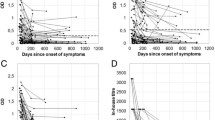Abstract
Sera of 112 healthy Hungarian blood donors were tested for the presence ofYersinia enterocolitica andY. pseudotuberculosis-specific agglutinins by tube agglutination, and for that of yersinia outer membrane protein (Yop)-specific IgA antibodies by ELISA. The positive results of this latter assay were confirmed by immunoblot. Only one sample gave a positive agglutination reaction withY. enterocolitica antigen (group O3) and four exhibited an equivocal reaction withY. pseudotuberculosis antigens (groups II and IV). Contrary to the low incidence of agglutinins, 15.1% of the samples showed a positive Yop-specific IgA reaction, while further 5.3% samples fell into the equivocal range by ELISA (17 and 6 specimens, respectively). Eleven of these samples (9.8% of all specimens tested) were also positive by immunoblot for the presence of Yop-specific IgA antibodies. These data suggest a higher incidence of yersinia infections than the 1.0–1.4 per 105 population predicted on the basis of stool culture results.
Similar content being viewed by others
References
Aldová E., Švandová E.:Yersinia enterocolitica O3 findings on porcine tongues in comparison with yersiniosis incidence in man in Czechoslovakia.J.Hyg.Epidemiol.Microbiol.Immunol. 28, 319–329 (1984).
Aldová E., Švandová E., Michalková M., Dvořáková H., Dědičová D., Mokelská E.: Long term yersiniosis surveillance project in Czechoslovakia.J.Hyg.Epidemiol.Microbiol.Immunol. 35, 167–188 (1991).
Anonymous: Infectious epidemiological data, Hungary, 2001.Epinfo 9 23 (2002).
Anonymous: System of Monitoring the Environmental Impact of Population Health of the Czech Republic. Summary Report 2002. National Institute of Health, Prague (www.szu.cz/chzp/rep02/szu_03an/ka03_07.htm) (2003a).
Anonymous: Infectious epidemiological data, Hungary, 2002.Epinfo 10, 31 (2003b).
Anonymous: Trends and sources of zoonotic agents in animals, feedingstuffs, food and man in the European Union and Norway in 2002, pp. 203–206 inCommunity Reference Laboratory on the Epidemiology of Zoonoses European Commission, Health & Consumer Protection Directorat-General (http://europa.eu.int/comm/food/food/biosafety/salmonella/08_yersinia_2002.pdf) (2004).
Bottone E.J.:Yersinia enterocolitica: the charisma continues.Clin.Microbiol.Rev. 10, 257–276 (1997).
Bottone E.J.:Yersinia enterocolitica: overview and epidemiological correlates.Microbes Inf. 1, 323–333 (1999).
Chatzipanagiotou S., Ladis V., Berdousi H., Palamidou F., Kourti E., Kattamis C.: Prevalence of yersinia plasmid-encoded outer protein (Yop) class-specific antibodies in multitransfused Greek patients with thalassemic syndromes.Clin.Microbiol.Infectol. 5, 67–72 (1999).
Chatzipanagiotou S., Legakis J.N., Boufidou F., Petroyianni V., Nicolaou C.: Prevalence ofYersinia plasmid-encoded outer protein (Yop) class-specific antibodies in patients with Hashimoto’s thyroiditis.Clin.Microbiol.Infectol. 7, 138–143 (2001).
Cornelis G.R.: TheYersinia Yop virulon, a bacterial system to subvert cells of the primary host defense.Folia Microbiol. 43, 253–261 (1998).
Czirók É., Lakos A., Horváth I., Dósa E., Szabó N., Budai I., Deák J., Lipcsey A., Bognár C.: Antibody detection, pp. 223–227 in É. Czirók (Ed.):Clinical and Epidemiological Bacteriology. (In Hungarian) Melania, Budapest 1999.
Czirók É.: Bacteriology, p. 71 inAnnual Report of the “Béla Johan” National Center for Epidemiology, 1999. (In Hungarian) Béla Johan Országos Epidemiológiai Központ, Budapest 2000.
Fredriksson-Ahomaa M., Korkeala H.: Low occurrence of pathogenicYersinia enterocolitica in clinical, food, and environmental samples: a methodological problem.Clin.Microbiol.Rev. 16, 220–229 (2003).
Füzi M.: Evaluation of the epidemiological, clinical and hospital hygiene laboratories, p. 39 inAnnual Report of the “Béla Johan” National Center for Epidemiology, 1999. (In Hungarian) Béla Johan Országos Epidemiológiai Központ, Budapest 2000.
Heesemann J.: Enteropathogenic yersinias: pathogenicity factors and new diagnostic methods. (In German)Immun.Infekt. 18, 186–191 (1990).
Hoogkamp-Korstanje J.A.A., De Koning J., Samsom J.P.: Incidence of human infection withYersinia enterocolitica serotypes O3, O8 and O9 and the use of indirect immunofluorescence in diagnosis.J.Infect.Dis. 153, 138–141 (1986).
Huter G., Mayer M., Eyer C., Jauris C., ReichhuberC., Kramer B., Soutschek E., Heesemann J.: Serological diagnosis ofYersinia infections withrecom Well Yersinia, the first enzyme immunoassay using recombinant antigens, pp. 1–3 in7th Internat. Congr. on Yersinia, Nijmegen (The Netherlands) 1998.
Kendrick C.J., Baker B., Morris A.J., O’Toole P.W.: Identification ofYersinia-infected blood donors by anti-Yop IgA immunoassay.Transfusion 41, 1365–1372 (2001).
Kienle Z., Kálmán M.:Yersinia, pp. 372–382 in É. Czirók (Ed.):Clinical and Epidemiological Bacteriology (In Hungarian) Melania, Budapest 1999.
Kihlstrom E., Foberg U., Bengtsson A., Fryden A., Svenungsson B., Schvarcz R., Lindblom B., Castor B.: Intestinal symptoms and serological response in patients with complicated and uncomplicatedYersinia enterocolitica infections.Scand. J.Infect.Dis. 24, 57–63 (1992).
Lahesmaa-Rantala R., Heesemann J., Lehtonen O.-P., Granfors K., Toivanen A.: Avidity of antibodies against released proteins ofYersinia spp.: comparison of patients with and without reactive arthritis.Ann.Rheum.Dis. 48, 1003–1006 (1989).
Maki-Ikola O., Heesemann J., Toivanen A., Granfors K.: High frequency ofYersinia antibodies in healthy populations in Finland and Germany.Rheumatol.Internat. 16, 227–229 (1997).
Smego R.A., Frean J., Koornhof H.J.: Yersiniosis — I. Microbiological and clinico-epidemiological aspects of plague and nonplagueYersinia infections.Eur.J.Clin.Microbiol.Infect.Dis. 18, 1–15 (1999).
Stahlberg T.H., Heesemann J., Granfors K., Toivanen A.: Immunoblot analysis of IgM, IgG, and IgA responses to plasmid encoded released proteins ofYersinia enterocolitica in patients with or without yersinia triggered reactive arthritis.Ann.Rheum.Dis. 48, 577–581 (1989).
Stolk-Engalaar V.M.M., Hoogkamp-Korstanje J.A.A.: Clinical presentation and diagnosis of gastrointestinal infections byYersinia enterocolitica in 261 Dutch patients.Scand.J.Infect.Dis. 28, 571–575 (1996).
Strieder T.G., Wenzel B.E., Prummel M.F., Tijssen J.G., Wiersinga W.M.: Increased prevalence of antibodies to enteropathogenicYersinia enterocolitica virulence proteins in relatives of patients with autoimmune thyroid disease.Clin.Exp.Immunol. 132, 278–282 (2003).
Szita J., Svidró A.: A five-year survey of humanYersinia enterocilitica infections in Hungary.Acta Microbiol.Acad.Sci.Hung. 23, 191–203 (1976).
Wenzel B.E., Heesemann J., Wenzel K.W., Scriba P.C.: Antibodies to plasmid-encoded proteins of enteropathogenicYersinia in patients with autoimmune thyroid disease.Lancet ii, 56 (1988).
Author information
Authors and Affiliations
Corresponding author
Rights and permissions
About this article
Cite this article
Sonnevend, Á., Czirók, É. & Pál, T. Yersinia Yop-Specific IgA antibodies in Hungarian blood donors. Folia Microbiol 50, 269–272 (2005). https://doi.org/10.1007/BF02931576
Received:
Issue Date:
DOI: https://doi.org/10.1007/BF02931576




